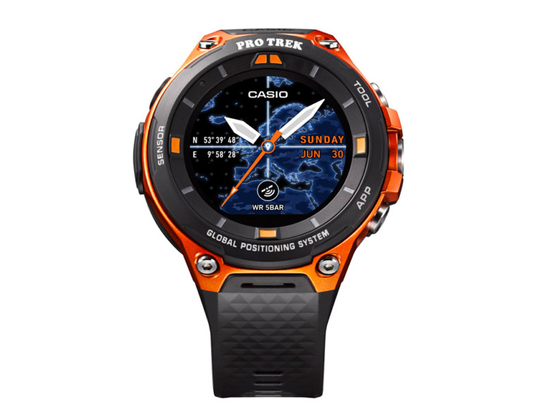
Dubai
Casio’s second Pro Trek smartwatch — WSD-F20 — is not a device to track the heart rate and sleep time, like the usual smartwatches in the market.
It is a device for adventurous and active outdoor people and looks like a top-end runner’s watch.
Even though its face is oversized and the super-chunky bezel, it has a 1.32-inch dual-layer circular touchscreen LCD, one colour screen with 320x300 pixels and then a separate monochrome LCD and works together superimposed on each other. Time is displayed on the monochrome layer and then apps on the colour LCD to save battery life. It runs on Android Wear 2.0 and weighs 92 grams.
It is a rugged watch and tested against the MIL-STD-810G standards for temperature, pressure and shock impact. The device is water-resistant up to 50 metres. The screen is covered with mineral glass and protected by the raised bezel.
The watch has a poor visibility in bright sunlight and all the buttons sit on the right side of the device. The top button called ‘Tool’ offers functionalities like a compass; sun rise and sunset times, an indicator of the day’s tide levels, altitude and barometric pressure.
The second button is the usual one for flicking between the apps menu and changing watch faces while the third one launches the location-tracking app.
On the left side is the proprietary magnetic charging port.
One good advantage is that when the watch is not in use, it turns to monochrome layer. The watch-only monochrome mode extends the battery from a day or so to a month.
The watch is good for hikers, fishing, runners, canoeing, skiing and cycling. The watch’s main purpose comes into play when there is no mobile signal out in the middle of the desert.
Map data downloading is handled through a tie-up with MapBox, a supplier of map data for countries worldwide. The map data can be displayed even when the user’s smartphone is offline or out of range of mobile device radio wave transmissions.
In the location-finder app, users can locate their location on the watch; add voice notes and memos to the visited places. The key feature is the ability to use offline maps. The built-in GPS chip set also supports GLONASS and Michibiki, yet another satellite system, which will improve tracking performance.
The disadvantage is that there is no way to track your stats other than the watch. It does offer the use of third-party apps like Google Fit Workout, Runkeeper, etc.
It has loads of sensors for tracking pressure (air pressure, altitude) sensor, accelerometer, gyrometer, compass (magnetic). Regarding connectivity, it has Bluetooth V4.1 (Low Energy) and WiFi (IEEE 802.11 b/g/n).
The watch has a storage capacity of 4GB and 512MB RAM. The battery gives around one day of use with GPS tracking and close to one-and-a-half days without GPS. The good side is that when the battery level is low to around 10 per cent, the device switches to watch-only mode.
The battery takes close to two hours to charge from zero to full. It is priced at Dh1,899.
Pros
Dual-layer screen display
Ruggedness
Offline maps
Plenty of sensors
Excellent watch-only mode battery life
Cons
Mediocre battery life with GPS
Bulky
Expensive
Poor screen visibility
Oversized watch face












